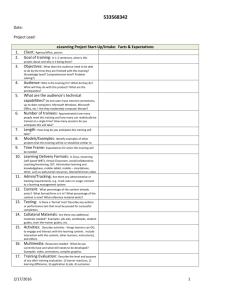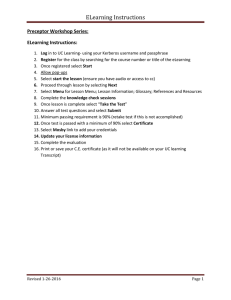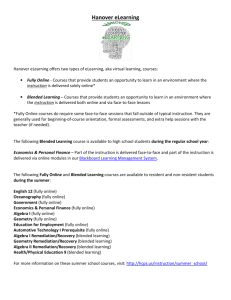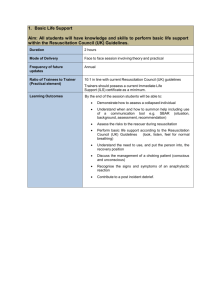UAS eLearning
advertisement
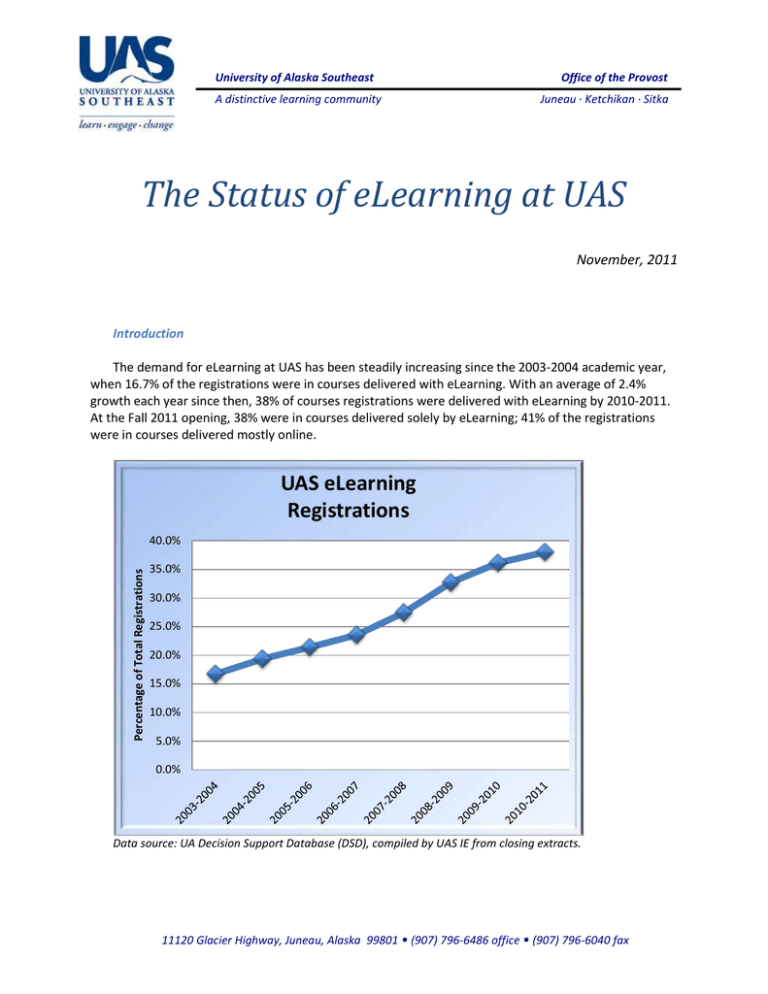
University of Alaska Southeast A distinctive learning community Office of the Provost Juneau · Ketchikan · Sitka The Status of eLearning at UAS November, 2011 Introduction The demand for eLearning at UAS has been steadily increasing since the 2003-2004 academic year, when 16.7% of the registrations were in courses delivered with eLearning. With an average of 2.4% growth each year since then, 38% of courses registrations were delivered with eLearning by 2010-2011. At the Fall 2011 opening, 38% were in courses delivered solely by eLearning; 41% of the registrations were in courses delivered mostly online. UAS eLearning Registrations Percentage of Total Registrations 40.0% 35.0% 30.0% 25.0% 20.0% 15.0% 10.0% 5.0% 0.0% Data source: UA Decision Support Database (DSD), compiled by UAS IE from closing extracts. 11120 Glacier Highway, Juneau, Alaska 99801 • (907) 796-6486 office • (907) 796-6040 fax Terminology Prior to Summer 2011, UAS courses were categorized as “distance”, “blended”, or “traditional”. Since Summer 2011, UAS courses have been categorized according to a scale describing ranges of the percentage of delivery that is location-based. The terminology used here is based on the following crosswalk for historical and current courses, and corresponds to descriptions that will be used to facilitate students’ course searches on UAOnline: Terminology eLearning Blended Traditional Current Courses 0% location-based (Banner code 0) 1-20% and 21-50% location-based (Banner codes 1 and 2, respectively) > 50% location-based (all other Banner codes) Historical Courses Distance (Banner codes X, Y, Z) Blended (Banner code H) Traditional (all other Banner codes) Source: Catalog & Schedule state-wide Banner work team, 10/27/2011 Endorsement, Certificate and Degree Programs by Delivery Of the 103 degree and certificate programs (including pre-majors) offered through UAS, 57 (55%) are currently available with eLearning (24 programs) and blended delivery (33 programs). Program Occupational Endorsement Undergraduate Certificate Associate/Associate of Applied Science Bachelor Master Graduate Certificate eLearning 3 Blended 4 5 4 8 2 2 3 4 9 8 5 Source: Updated from a Spring 2011 state-wide survey of department representatives, coordinated by Sally Mead. Unlike courses, degree and certificate programs are not encoded in Banner for delivery methods. Program delivery categories are based on the percentage of required courses available in each delivery category. Page 2 Status of eLearning at UAS, Fall 2011 eLearning and Blended Program Enrollment (HC) and Student Credit Hours (SCH) Twenty-two (22) eLearning and Blended programs have been introduced since academic year 2009, and 20 have been discontinued. More students are seeking other UA degrees than any single UAS program; there was an increase in students of about 4% from 2009 – 2011, and 6.5% increase in credit hours. Of UAS programs available with eLearning and Blended deliveries, the AA degree program remains the most popular by headcount, followed by the BBA in Accounting, and the BA in Elementary Education. Program Other UA Students OEC Accountant OEC Child Development Associate Delivery eLearning eLearning eLearning OEC Healthcare Information Technology CT1 Health Information Mgt CT2 Accounting Technician CT2 Early Childhood Education eLearning eLearning eLearning eLearning CT2 Health Info Mgmt Coding Specialist CT2 Healthcare Privacy & Security AA General Program AAS Business Administration AAS Early Childhood Education AAS Health Information Mgt BA - Elementary Education BBA - Accounting BBA - Entrepreneurship BBA - General Business (Discontinued) BBA - Health Care Administration (Discontinued) BBA - Human Resources Management BBA – Management (Discontinued) BBA - Marketing BBA Pre-major BLA Independent Design BLA Interdisciplinary Studies MBA (Discontinued) eLearning eLearning eLearning eLearning eLearning eLearning eLearning eLearning eLearning eLearning eLearning eLearning eLearning eLearning eLearning eLearning eLearning eLearning 2009 HC SCH 1585 6778 2010 HC SCH 1588 6979 1 8 2011 HC SCH 1654 7219 9 33 1 12 2012 HC SCH 902 3773 5 31 2 7 197 217 7 23 34 2 141 295 4 7 1 36 4 196 101 30 47 86 116 27 21 2955 1144 214 531 1731 1628 368 257 24 18 229 113 28 71 105 143 30 14 203 146 3229.5 1241 238 894 2001 1964 378 186 31 12 264 112 25 74 121 186 34 9 372 84 3860.5 1390 226 1060 2491 2601 429 99 31 8 196 89 24 57 103 180 29 5 260.5 38 2029.5 799 158 469.5 1343 1767.5 312 40 4 38 39 44 4 60 481 459 705 45 4 60 24 48 1 46 686 277 708 12 2 60 13 45 16 738 167 611 3 53 22 27 2 25 459 212 260 11 484 37 46 590 538 1 71 51 25 1221 477 62 37 602 273 21 22 1 45 95 4 376 33 7 1 33 3 43 14 236 13 Page 3 Status of eLearning at UAS, Fall 2011 Program MBA - Global Leadership (Discontinued) MED - Special Education MPA Graduate Cert - Business Graduate Cert - Special Education OEC Admin Office Supp OEC Medical Office Supp (Discontinued) OEC Network Admin OEC Network Support Technician OEC Programming Foundations (Discontinued) OEC Web Authoring (Discontinued) OEC Web Development and Admin (Discontinued) OEC Web Development OEC Web Foundations (Discontinued) CT2 Admin Office Support (Discontinued) CT2 Computer Info Office Systems CT2 Network Admin CT2 Programming Functions (Discontinued) CT2 Web Development CT2 Web Foundations (Discontinued) Delivery eLearning eLearning eLearning eLearning eLearning Blended Blended Blended Blended Blended Blended Blended Blended Blended Blended Blended Blended Blended Blended Blended 2009 SCH HC 56 47 671 392 73 2 678 42 1 2 32 9 5 58 12 171 1 2010 SCH HC 29 2011 SCH HC 2 64 50 6 72 3 1 9 855 402 72 827 37 4 1 2012 SCH HC 3 2 79 58 3 82 2 1 1 1 33 928 486 9 898 12 11 10 6 2 74 52 18 848 284 82 2 2 1 946 6 8 12 3 29 2 18 1 3 5 1 8 1 1 2 2 10 25 39 9 93 7 7 38 18 2 1 3 16 1 13 1 36 150 12 4 13 10 1 76 1 1 27 1 8 1 30 AAS Computer Info Off Sys Network and Systems Admin (Discontinued) Blended AAS Computer Info Off Sys Network Technician Blended 2 41 11 140 28 428 24 266 AAS Computer Info Off Sys Office Administration (Discontinued) Blended 2 12 7 108 9 117 10 97 AAS Computer Info Off Sys Publications Specialist (Discontinued) Blended 3 24 6 48 1 1 AAS Computer Info Off Sys Web Development AAS Computer Info Office Systems AAS Fisheries Technology BA English Blended Blended Blended Blended 131 208 201 893 19 5 23 55 242 51 249 926 143 390 104 915 10 17 14 46 15 26 11 49 19 37 159 431 Page 4 Status of eLearning at UAS, Fall 2011 BA Social Science BA Social Science - Anthropology BA Social Science - Economics BA Social Science - Government BA Social Science - History BA Social Science - Psychology BA Social Science - Sociology BA Undeclared Delivery Blended Blended Blended Blended Blended Blended Blended Blended HC 34 23 2 10 18 29 12 2009 SCH 372.5 424 26 174 314 472 172 BS Information Systems - Networking (Discontinued) Blended 2 21 1 3 BS Information Systems - Programming (Discontinued) Blended 4 72 3 32 3 BS Information Systems Pre-major (Discontinued) MAT - Early Childhood Education MAT - Elementary Distance MAT - Undeclared MAT - Secondary Education MED - Early Childhood Education MED - Educational Leadership MED - Educational Technology MED - Mathematics K-8 MED - Reading MED - Secondary Education (Discontinued) Blended Blended Blended Blended Blended Blended Blended Blended Blended Blended Blended 1 5 87 2 69 18 31 36 1002 30 1187 150 40 15 37 1 305 157 296 6 1 3 89 2 67 24 20 36 16 44 22 33 1135 9 1080 192 483 239 162 372 5 98 1 61 15 35 31 21 54 MED - Undeclared Blended 1 5 Program 2010 SCH 9 153 26 406 7 113 9 140 17 280 31 550 11 203 2 50 HC 2011 SCH 8 101 22 378 4 89 8 132 16 220 46 869 13 202 HC 2012 SCH HC 1 15 2 8 11 40 9 13 218 25 94 119 476 101 21 1 16 42 1108 9 1186 128 609 188 220 468 4 76 1 52 12 32 23 19 59 30 583 18 619 91 478 126 144 358 Blended 16 128 23 198 18 185 15 120 Graduate Cert - Early Childhood Education Blended 40 308 39 255 30 212 22 121 Graduate Cert - Educational Technology Blended 78 1080.5 88 1314 92 1457 69 577 Graduate Cert - Elementary Education Blended 23 232 22 196 24 221 24 158 Graduate Cert - Mathematics K-8 Blended 26 217 38 353 45 434 48 322 Graduate Cert - Reading Grand Total 3311 29042 3609 32979 3868 36783 2760 21299 Source: UA Decision Support Database, compiled by UAS IE from closing extracts through Summer 2011, and opening extracts for Fall 2011. Academic year 2012 data includes only Summer and Fall, 2011. Students having secondary curricula were determined from Banner data tables. Duplicated for students in more than one program. Page 5 Status of eLearning at UAS, Fall 2011 Course Enrollment (HC) and Student Credit Hours (SCH) The number of enrollments in courses with eLearning delivery has increased 21% from academic year 2009 to 2011, compared to an 8% increase in Traditional courses. The largest enrollment increase in eLearning has been in lower division courses (29.6%); the largest decline is in Professional level courses. Several courses (especially Special Education, English, Mathematics, and Early Childhood Education) have been recently designated as having Blended delivery. 2009 2012 HC SCH 15 162 509 Blended 185 552 Blended Total 15 33 347 1061 Developmental 421 1595 475 1805 504 1926 207 791 eLearning Lower Division 4562 12829 5319 15645 5911 17809.5 2357 7360 Upper Division 1871 5330 2025 5727 2227 6221 1048 2983 Graduate 2036 5679 2063 6054 2148 6449 843 2478 Professional 26 59 749 1280 16 29 10 20 eLearning Total 8916 25492 10631 30511 10806 32435 4465 13632 Developmental 971 3734 1044 4022 1175 4507 844 3111 Traditional Lower Division 8525 23915 9571 27845.5 9929 29156.5 5246 15813 Upper Division 2482 7058 1935 5491 1999 5760 1274 3620 Graduate 1631 4470 1572 4581 1710 5135 1191 3676 Professional 1907 3178 1902 3470 2000 3772 390 803 Traditional Total 15516 42355 16024 45410 16813 48331 8945 27023 Grand Total 24432 67847 26655 75921 27634 80798 13757 41716 Source: UA Decision Support Database (DSD), compiled by UAS IE from closing extracts through Summer 2011, and opening extracts for Fall 2011. Academic year 2012 data includes only Summer and Fall, 2011. Delivery Level Lower Division Graduate HC 2010 SCH HC 2011 SCH HC SCH 33 Page 6 Status of eLearning at UAS, Fall 2011 Degree and Certificates Awarded About 40% of the endorsements, certificates and degrees awarded from academic year 2009 to 2011 have been in eLearning programs, 34% in Blended programs, and 25% in Traditional programs. 2009 2010 2011 Grand Total Blended 100 138 158 396 eLearning 138 150 181 469 Traditional 71 89 130 290 Source: UA Decision Support Database (DSD), compiled by UAS IE from closing extracts. Degree and Certificate Graduates’ Course Delivery Two of the students who earned an endorsement, certificate or degree in 2009 had taken 100% of their courses with eLearning delivery, compared to 24 who had done so by the time they graduated in 2011. Most graduates took between 1% and 20% of all their courses at UAS via eLearning. Pct of all Courses by eLearning Graduates 2009 2010 2011 Grand Total 0% 113 71 82 266 1-20% 112 104 88 304 21-50% 51 100 115 266 51-99% 8 72 116 196 100% 2 7 24 33 Grand Total 286 354 425 1065 Source: UA Decision Support Database (DSD), compiled by UAS IE from closing extracts. All courses the graduates ever took at UAS (since 1998) were considered, not just the courses required for the degree program. Students enrolled in UAS classes the last three years are more polarized. Last year, 54% (3,650) of the students took only Traditional courses and 34% (2,284) took only eLearning classes. Pct of Year's Courses Students by eLearning 2009 2010 2011 Grand Total 0% 3429 3449 3650 10528 1-20% 98 141 154 393 21-50% 319 351 337 1007 51-99% 275 315 314 904 100% 1918 2190 2284 6392 Grand Total 6039 6446 6739 19224 Source: UA Decision Support Database (DSD), compiled by UAS IE from closing extracts. Page 7 Status of eLearning at UAS, Fall 2011 Course Completion Course completion rates by delivery were evaluated in terms of three completion categories. Grades of D or higher, pass grades, and CR (credit) grades were counted as successful completion. Stasis grades include audits, no basis grades, incompletes, and withdraws; F’s were counted as failures. There were too few Blended courses to provide meaningful completion rates. As might be expected, there has consistently been greater success rates for Traditional courses. However, success rates have been improving and the percentage of stasis grades has been decreasing for both eLearning and Traditional courses. 2009 2010 Delivery Success Stasis Failure Success Stasis Failure Success 70.9% 25.1% 4.0% 73.0% 21.8% 5.2% 79.1% eLearning (2028) (719) (113) (2465) (735) (176) (6419) 78.7% 18.9% 2.4% 85.2% 13.4% 1.4% 85.6% Traditional (1258) (302) (39) (1399) (220) (23) (9452) Source: UA Decision Support Database (DSD) compiled by UAS IE from closing extracts. 2011 Stasis 16.7% (1351) 11.0% (1211) Failure 4.2% (342) 3.5% (383) eLearning Structure at UAS At UAS, elearning options are methods of delivering course material. Schools and departments evaluate program goals and make the decision to incorporate eLearning based on student population needs and program objectives. UAS degree programs are managed at the school level. Since 1999, UAS course web sites have used a ‘hybrid’ strategy combining commercial tools, including Blackboard, with custom software to deliver an integrated brand-neutral system. Beginning with Fall 2012 classes, all UAS course web sites will be delivered by the Blackboard Learn server managed by UAS ITS Services. UAS policies contribute to a successful eLearning environment, in particular: 1) requiring that every UAS course have an active web site; 2) requiring that these sites be available to students and the public as soon as the course schedule is published; 3) requiring course syllabi be published on all course sites; 4) retaining course web sites indefinitely; 5) leveraging course web sites to deliver institutional as well as course resources; 6) leveraging course web sites to collect student ratings of courses. Support and Training for eLearning through UAS Faculty development seminars along with group and one-on-one training with ITS staff are available. UAS policies mandate the use of course websites and similar technologies. Consequently, there is a 90% adoption of web course management technologies across all programs and courses – not just those online. Also, 46% of UAS students providing course evaluations ‘strongly agree’ that technology is used effectively in instruction; this is twice the national average of 22% for this metric. Faculty in the Schools of Management and Education mentor new and adjunct faculty to ensure they are prepared for instruction through online delivery methods. Education Technology faculty help their colleagues with online teaching assignments. iTeach training is offered regularly in Sitka or Juneau to expand the use of online instruction technologies. In the UAS School of Education, where the majority of graduate degree programs are delivered via eLearning, the class size is usually capped at 20% less than for location-based classes. Page 8 Status of eLearning at UAS, Fall 2011 Cooperation and Coordination with Other MAUs UAS core technology resources are available to students at any UA campus, and students signing into UAS systems see all their courses at all UA campuses. This includes both their current UA courses as well as any course they have taken back to the 1990s. UAS continues to collaborate with the IT organizations at UAA and UAF. UAA has provided hosting for Eluminate live for both UAA and UAS. UAS has created self-service tools to login functions (ELMO) that have been adopted throughout the UA system. Close ties between the AAS in Early Childhood Education at UAS and UAF makes UAF students eligible for priority registration for UAS courses; otherwise the priority registration period is limited to UAS degree-seeking students. Quality and Assessment Assessment plans are in place for all degree programs regardless of delivery method. Assessments are reviewed annually and the results reported to Deans and Directors. Institutional Concerns Online learning is an essential part of Schools of Education and Management programs, and is in use throughout the Schools of Arts & Sciences and Career Education. The specific approach or delivery method may vary between schools since programs are delivered depending on the target audience and program goals. ELearning is not a function separate from course or program delivery but applied as appropriate. In reviewing student comments on ITS services there is a desire for advance notice of technologies that will be used in the class and an interest in seeing additional standards in the use of the technology, e.g. required use of electronic grade book. However, these suggestions come from students taking either or both online and location-based courses. Clearly, meeting the information and instruction needs of off-site students is critical, and a renewed focus in recent years has increased the resources available for these students. For example see: http://uas.alaska.edu/distance/ for a compilation of resources addressing such essential information as registration, tuition and FAQs. Recently a distance version of freshman and transfer student orientation has been developed to address the specific needs of eLearning students: http://uas.alaska.edu/orientation/distance/index.html. UAS Library websites prominently displays relevant information for Distance Education at: http://www.uas.alaska.edu/library/services/distance-ed.html. Page 9 Status of eLearning at UAS, Fall 2011
